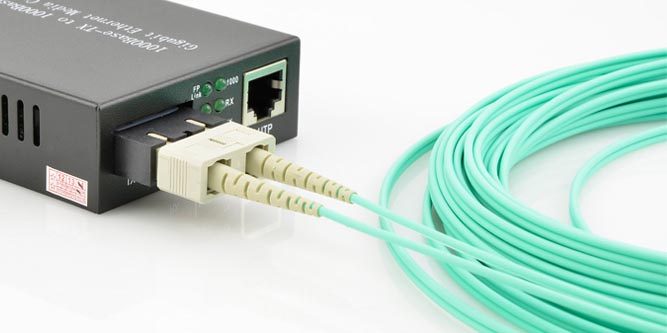With the introduction of fiber optics in the telecommunications world, it has become increasingly important for businesses to stay up to date with their technology. If you’re not using fiber to Ethernet converters, you could be left behind by your competitors. But what exactly are these converters and why are they so important? In this blog post, we will explore what fiber to Ethernet converters are and the key benefits that businesses can gain from implementing them in their networks. We will also discuss the factors that should be taken into consideration when purchasing such devices. Read on to learn how you can get ahead of the competition with a reliable and effective network infrastructure setup.
What is a fiber to Ethernet converter?
As the world increasingly turns to digital communication, the need for fast and reliable internet connections has never been greater. Fiber to Ethernet converters provide a way to connect devices that use Ethernet cables to devices that use fiber optic cables. This allows for a faster and more reliable connection between devices.
Fiber to Ethernet converters are available in a variety of different speeds, depending on the needs of the user. The most common types of fiber to Ethernet converters are 10/100Base-T and 1000Base-T. 10/100Base-T is typically used for lower speed applications such as email and web browsing, while 1000Base-T is used for higher speed applications such as streaming video or gaming.
When choosing a fiber to Ethernet converter, it is important to consider the speed and distance that the converter will need to support. For example, if you are connecting two devices that are close together, you may not need a high-speed converter. However, if you are connecting two devices that are far apart, or if you plan on using the converter for high-speed applications, you will need a faster converter.
There are many different manufacturers of fiber to Ethernet converters, so it is important to do your research before purchasing one. Some things you may want to consider include price, features, and warranty. Once you have found a few options that meet your needs, compare them side by side to find the best deal.
How do fiber to Ethernet converters work?
Fiber to Ethernet converters work by converting the optical signals from a fiber optic cable into electrical signals that can be sent over an Ethernet cable. This allows businesses to take advantage of the high speed and reliability of fiber optic cables while still using the more common and less expensive Ethernet cables.
Fiber to Ethernet converters typically have two ports, one for the incoming fiber optic cable and one for the outgoing Ethernet cable. The converter will also have a power port to connect to a power source. To install a fiber to Ethernet converter, simply connect the incoming fiber optic cable to the port labelled “In” and the outgoing Ethernet cable to the port labelled “Out”. Then, plug the power cord into an outlet and turn on the converter.
Once the converter is powered on, it will begin converting optical signals into electrical signals. These electrical signals can then be sent over an Ethernet cable to another device, such as a computer or router. Fiber to Ethernet converters are typically very small devices that can be easily mounted on a wall or desk.
What are the benefits of using a fiber to Ethernet converter?
An Ethernet fiber converter can offer a number of advantages over traditional copper-based Ethernet cabling. Here are some of the key benefits:
- Increased Speed and Bandwidth – Fiber optics offer much higher bandwidth than copper cables, which means that you can achieve faster data transfer speeds. This is particularly important for applications that require large amounts of data to be transferred quickly, such as video streaming or file sharing.
- Reduced Interference – Because fiber optic cables are not affected by electromagnetic interference (EMI), they can offer a clearer signal than copper cables. This is especially beneficial in environments where there is a lot of electrical equipment, such as in office buildings or data centers.
- Greater Distance Support – Fiber optic cables can support data transmissions over much greater distances than copper cables. This makes them ideal for connecting distant locations, such as between different buildings or across a campus.
- Improved Security – Fiber optics are more difficult to tap into than copper cables, which makes them more secure against eavesdropping and other security threats.
How to choose the right fiber to Ethernet converter for your needs
If you’re looking to convert your fiber optic connection to Ethernet, you’ll need a fiber to Ethernet converter. But with so many on the market, how do you know which one is right for your needs?
Here are a few things to consider when choosing a fiber to Ethernet converter:
- Speed: How fast do you need your converter to be? 10Mbps, 100Mbps, or 1000Mbps? Make sure to choose a converter that can handle the speed you need.
- Protocols: What protocols does your network use? If you’re not sure, ask your network administrator. Some converters only work with specific protocols, so this is an important consideration.
- Connectivity: How many devices do you need to connect? Some converters only have one port, while others have multiple ports. Make sure to choose a converter with enough ports for your needs.
- Budget: Like anything else, there are options at different price points. Decide how much you’re willing to spend on a converter and then compare features to find the best value for your money.
Conclusion
In short, fiber to Ethernet converters are an essential tool for any business or organization that wants to stay ahead of the competition. By allowing users to quickly and easily convert their existing fiber networks into more efficient Ethernet ones, these devices are a cost-effective way of ensuring reliable connectivity and faster speeds. With the right converter in place, businesses can maximize their network performance while reducing costs at the same time – making them a must-have piece of equipment for anyone looking to keep up with today’s ever-evolving digital world.

